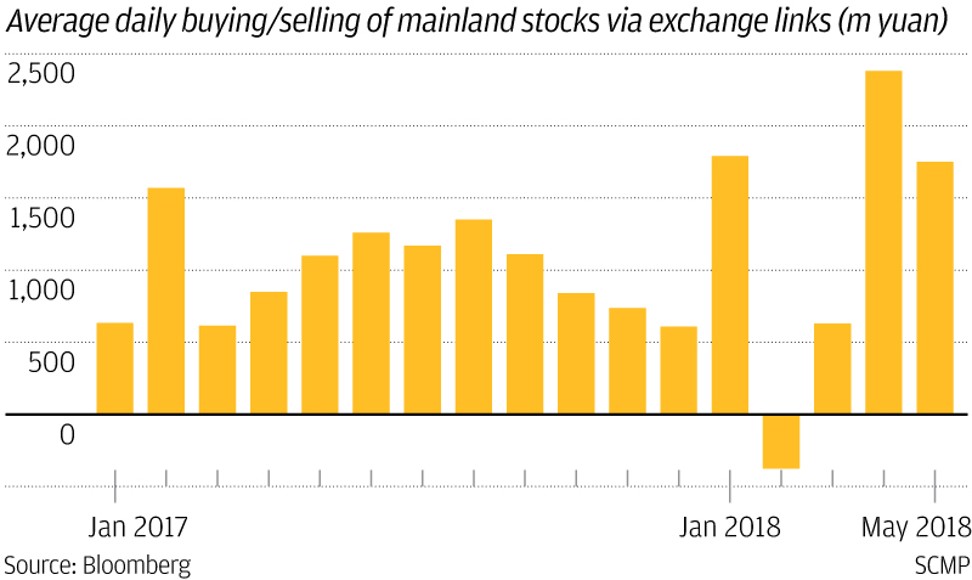
US$400 billion expected to flow into Chinese stocks after MSCI inclusion: top fund manager
Asian investors could be the first movers after the MSCI inclusion, while European and US institutions may proceed with more caution
MSCI’s inclusion of China shares in its benchmark Emerging Markets Index will trigger foreign inflows of up to US$400 billion in the next 10 years, with an initial US$20 billion expected this year from ETFs and active funds, according to CSOP Asset Management, the world’s biggest RQFII asset manager that helps channel offshore yuan into mainland stocks and bonds.
The inclusion of yuan-denominated A shares, which are listed in either Shanghai or Shenzhen, in MSCI’s Emerging Markets Index will be effective on June 1. As many as 234 big-caps will be added in a two-step process in June and September, giving them an initial weighting of 0.78 per cent.
“Overseas investors have already speeded up asset allocation to Chinese equities in the past few months,” said Louis Lu, head of quantitative and alternative investments at CSOP. “This is good timing as the A-share valuation is relatively cheap at the moment.”

Northbound fund flows from Hong Kong to mainland China via the stock connect schemes have been increasing sharply, with April alone accounting for 38.65 billion yuan, the biggest since the start of 2017, data from the Hong Kong stock exchange showed.
MSCI unveils list of A shares in closely tracked investment index
Of these fund flows since June 2017, more than 75 per cent have gone into Chinese stocks outlined by the MSCI previously. Five sectors that attracted the most capital were financials, industrials, materials, IT, and consumer staples, according to exchange data.
After MSCI’s inclusion, sovereign wealth funds from Southeast Asia and the Middle East could become “first movers” to enter the A-share market, according to a recent survey by CSOP of global asset managers, private banks and other institutional investors, which manages more than 46 billion yuan (US$7.2 billion) under the Renminbi Qualified Foreign Institutional Investor scheme.
Global investors tuck into China stocks as MSCI inclusion nears
“We expect Asian investors to be the first movers as they are more familiar with the nature of the A-share market, how to access the market and what investment tools to adopt,” said Melody He, head of sales and product strategy at CSOP.
We expect Asian investors to be the first movers as they are more familiar with the nature of the A-share market
Big Southeast Asian institutions may use exchange traded funds to enter the A-share market and react quickly after the inclusion becomes effective.
However, investors from Hong Kong, Taiwan, Singapore and South Korea may adopt a more flexible strategy, as many of them already have overweight positions in A shares.
“They are likely to watch the market sentiment and ride on a MSCI rally,” said He.
Bigger stock connect quotas to cater to inflows when MSCI includes China
Meanwhile, institutional investors from the US and Europe may act more slowly than Asian investors, the asset management firm predicted.
Among them, big fund houses may move first and are likely to start increasing A-share allocation with passive tools, such as ETFs. Active products may follow up if clients ask for an increased exposure to China.

Mid-size money managers may closely watch the moves by big funds and follow them.
Pension funds are likely to be the most cautious, as these long-term big investors need more time to “observe the China market after the inclusion”.
“MSCI inclusion does provide a ‘jump start’ effect on their interests in China, but those big ticket buyers [pension funds] will only proceed with caution,” said He.
Hong Kong takes steps to ensure liquidity when MSCI adds China
“They are less prepared for the inclusion, as they think the weighting is small and US domestic market is still resilient.”
Top concerns for the pension funds include the yuan’s strength, potential reversal of China’s current policies, and trade conflicts with the US, the survey showed.


